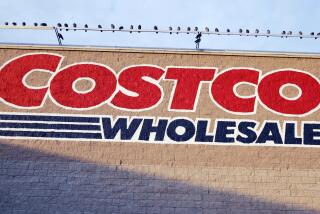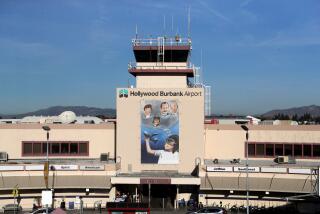Security Upgraded at Airport : Aviation: New system at Burbank airfield is designed to keep intruders, including unauthorized employees, from runways.
Burbank airport has become the first airport in California to complete installation of a high-tech security system to keep intruders--including unauthorized airport and airline employees--from runways and other restricted areas, airport officials said Monday.
The $83,000 system was installed in response to stringent federal regulations adopted in 1990 after what Federal Aviation Administration officials said were security breakdowns at airports across the nation. It requires employees to insert identification badges bearing coded magnetic strips into a slot to unlock doors to flight aprons.
The advantage of the new system, say local and federal aviation officials, is that Burbank airport officials can instantly revoke an employee’s access to sensitive airport areas by changing the employee’s classification on a computer terminal.
The new system also can be programmed to allow access only on certain days of the week or during certain hours, ensuring that an employee can gain access only during scheduled work hours, they said.
The new system also records each employee’s use of a door, allowing airport officials to determine which employees were present in a secured area at a given time.
Previously at Burbank, doors to aprons and runway areas were secured by combination locks and key-operated locks. Employees needing access to the area were given keys or the code numbers. There are no backup security measures, such as guards, at these doors.
The security upgrade is part of an FAA mandate outlined in the Aviation Security Improvement Act passed by Congress in 1990. That bill followed recommendations by a presidential commission on aviation security and terrorism, appointed after the 1988 Lockerbie disaster in which a bomb placed aboard a Pan American jet in Germany by terrorists exploded over Scotland, killing 270 people.
But the security breach that FAA officials say most demonstrates the need for tighter security measures at U.S. airports occurred at Los Angeles International Airport a year before the Lockerbie crash.
During that incident, a disgruntled former Pacific Southwest Airways employee used his ID badge to board a PSA jet with a gun. Authorities believe that during the flight to San Francisco, the man shot the cockpit crew, causing the plane to crash near Paso Robles, killing all 43 people on board.
FAA officials said the PSA incident tragically demonstrated a weakness at the nations’ airports that the stricter regulations attempt to address.
“There have been indications over the years that there is the possibility of breaching the system,” said FAA spokesman Fred O’Donnell.
Many airports distribute employee-access cards, which are not confiscated when employees leave their jobs. “We want something that is updated hourly, if at all possible, to keep up with employees and their work schedule,” he said.
Los Angeles International Airport has submitted plans to the FAA for a similar system, scheduled to be operational by the end of this year, officials said. Installation of such a system has been delayed at Ontario Airport, also owned by the city of Los Angeles. Officials said they are uncertain when that system will be operational.
Officials at John Wayne Airport in Orange County installed an ID-access system in September, 1990, when the airport’s operations were moved to a new terminal. But O’Donnell said the system there does not meet FAA requirements. He declined to elaborate, saying that discussing security problems would provide information to anyone planning to circumvent the system.
Federal aviation officials said commercial airports across the nation were required to submit a plan to install improved security systems and have them on line before 1994.
More to Read
Sign up for Essential California
The most important California stories and recommendations in your inbox every morning.
You may occasionally receive promotional content from the Los Angeles Times.











